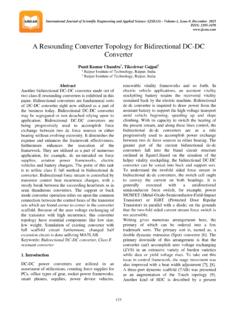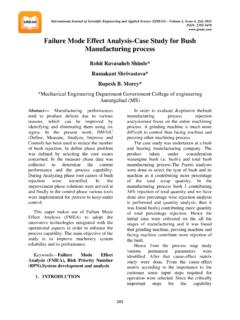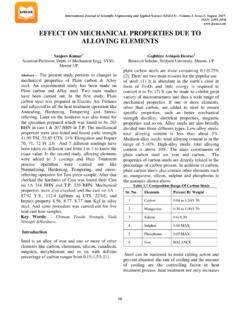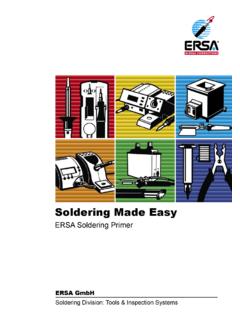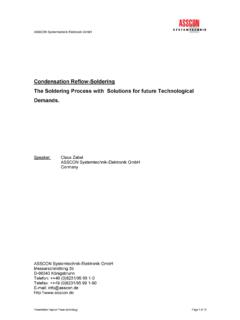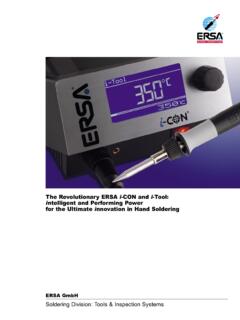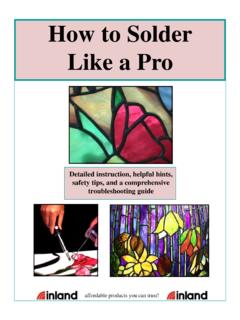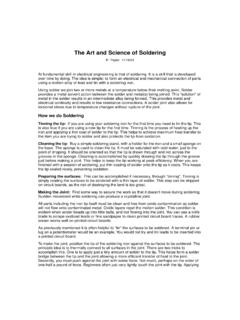Transcription of RECENT ADVANCES IN SOLDERING/BRAZING AND …
1 International Journal of Scientific Engineering and Applied Science (IJSEAS) - Volume-1, Issue-4, July 2015 ISSN: 2395-3470 93 RECENT ADVANCES IN SOLDERING/BRAZING AND WELDING IN DENTISTRY Dr C SabarigirinathanP1P,Dr K VinayagavelP2P,Dr P RupkumarP3P,Dr G SriramprabhuP4P,Dr V HarishnathP5P,Dr Vinay BhartiP6 P1P(Professor and HOD,Dept of Prosthodontics,Tamilnadu Govt Dental College & Hospital,Chennai,India) P2P(Professor,Dept of Prosthodontics,Tamilnadu Govt Dental College & Hospital,Chennai,India) P3,4P(Associate Professor,Dept of Prosthodontics,Tamilnadu Govt Dental College & Hospital,Chennai,India) P5P(Senior Assistant Professor,Dept of Prosthodontics,Tamilnadu Govt Dental College & Hospital,Chennai,India) P6P(Post Graduate Student,Dept of Prosthodontics,Tamilnadu Govt Dental College & Hospital,Chennai,India) Abstract: The fit of multi-unit dental prosthesis which is prevailingly termed as fixed partial dentures FPD S is the most frequent hassle encountered nowadays.
2 Restorations that produce a ill fit may precipitate mechanical failure of the denture resulting due to screw failure or abutment caries. soldering and welding define a solution to overcome the problem of ill-fitting is a fixed dental prosthesis which is multiunit. This article mainly focuses on the principles of soldering , the parameters affecting the outcomes of this technique, and the obtained dimensional accuracy of soldering . The art of soldering is explained in relation to fit of cemented and screw retained prosthesis is being explained. A comprehensive chancery of principles, the background, theory, working terminologies is being elaborately included in the article. Introduction: SOLDERING/BRAZING and welding is a metal joining technologies. There are two ways of joining metals in dentistry SOLDERING/BRAZING and welding. In soldering , an intermediate alloy or solder flows between and around, and unites the parts to be joined. When joining by welding, the parent metals to be joined are fused in the joint area.
3 soldering as a technique dates back at least 2000 years to Roman times, with the use of lead-tin solders for joining lead water pipes. Today, joining domestic copper water pipes with lead tin solders is standard in plumbing. International Journal of Scientific Engineering and Applied Science (IJSEAS) - Volume-1, Issue-4, July 2015 ISSN: 2395-3470 94 soldering is the process of joining metal using an intermediate metal alloy whose melting temperatureis lower than that of the solidus temperature of the metal to be to be joined is parent metal and metal used for joining parent metal is solder or filler parts to be joined are not melted during soldering ,but must be thoroughly wetted by liquefied solder. The standard soldering techniques are called freehand and investment solderingP1P. Upon melting, the solder alloy flows by capillary action between and around the adjacent heated but unmelted parts to be processes, which are conventionally called soldering in dentistry, actually use brazing or welding alloysP3P.
4 soldering is similar to difference in the melting point of the filler melt at temperature below 840 degree F(450 degree C) and in brazing filler materials melt at temperature above this pointP2,4,5P. brazing is a term used operation at or above 450 degree C is generally termed dental soldering procedures are actually brazing but the names are used interchangeably in is defined as a joining by the fusion of filler metals between them at a temperature below the solidus temperature of metals being joined and above 450 degree C P2,4P. WELDING is the process of joining two pieces of similar metals without addition of another has a very limited use in prosthodontics. It is usually used to join flat surfaces like bands and brackets,in pedodontics to weld bands and other appliances,in prosthodontics to join wrought wire clasps and repair of broken metal partial dentures. APPLICATION OF soldering IN PROSTHODONTICS: 1. Assemble long span fixed partial dentures. 2. Joining wrought wire clasps arms to cast partial dentures framework.
5 3. Joining precision attachments. 4. Joining sections of metal superstructure for implant supported restorations etc. 5. To overcome distortion in multiunit cast fixed prosthesesP2,5,6P. 6. Repair of perforated crown and bridges. 7. Develop contacts points I crown. 8. Cutting and rejoining of ill fitted distorted bridge. REPAIR OF CAST PARTIAL DENTURE International Journal of Scientific Engineering and Applied Science (IJSEAS) - Volume-1, Issue-4, July 2015 ISSN: 2395-3470 95 MATERIAL SCIENCE: (A).SUBSTRATE METAL: Parent metal is the metal or alloy to be is also known as a substrate metal or base metal. HIGH NOBEL METAL ALLOYS BASE METAL ALLOYS (B).DENTAL SOLDERS: They are intermediate filler alloy used to join parent metal parts. REQUIREMENTS OF DENTAL SOLDERS: appropriate flow temperature. fluidity at flow temperature. to wet the substrate metal. resistant. International Journal of Scientific Engineering and Applied Science (IJSEAS) - Volume-1, Issue-4, July 2015 ISSN: 2395-3470 96 5.
6 Strength similar to that of the parent alloyP5 SOFT SOLDERS HARD SOLDERS (a).Gold based solder (b).Silver based solder (C). soldering FLUX: Purpose of flux is to remove any oxide coating on the substrate when the filler metal is fluid and ready to flow into place. CLASSIFICATION OF FLUXES: Surface protection(type 1) Reducing agent(type 2) Solvent(type 3) Commonly soldering fluxes are: Borax Flux: Composition: Borax glass 55%,Boric acid 35%,Silica 10% Fluoride Flux: Composition: Borate,Fluoride soldering FLUX (D). soldering ANTIFLUX: They limit spread of solder to unwanted used anti fluxes are: Graphite-economical and evaporates at high temperature. Iron oxide(rouge)+turpentine-it is painted on casting with small bristle brushP5,8P. International Journal of Scientific Engineering and Applied Science (IJSEAS) - Volume-1, Issue-4, July 2015 ISSN: 2395-3470 97 soldering ANTIFLUX (E). soldering INVESTMENT: Composition of soldering investment is similar to routinely used gypsum and phosphate-bonded the refractory component used is fused quartz(it shows least thermal expansion-< at temp>700 degree C.)
7 soldering INVESTMENT (F).HEAT SOURCE: ELECTRIC soldering ,FLAME,OVEN,INFRARED soldering ,DIGITAL soldering . soldering JOINT CONFIGURATION: Strength,Cosmetics,Hygiene International Journal of Scientific Engineering and Applied Science (IJSEAS) - Volume-1, Issue-4, July 2015 ISSN: 2395-3470 98 Larger bucco lingual and occluso gingival dimensions are,the stronger the joint will be. In posterior regions-rounded triangular shape In anterior-oval shaped. soldering GAP JOINT: Stade et al(JPD 1978)-atleast gap be present,but should be less than soldering DEFECTS AND CORRECTION: of the prosthesis to fit: -disassembled and resoldered Causes: failure to maintain the proper relationship of the parts Improper heating of the assembly of integrity:Soldered joints with pits or voids are not acceptable size or form WELDING: Welding is a process of joining two metal pieces as a result of significant diffusion of the atoms of the welded pieces into the joint is carried out by heating the joined pieces to melting point and fusing them together(with or without filler material) or by applying pressure to the pieces in cold or heated state.
8 Advantages of welding: -Strong and tight joining -Cost effectiveness -Simplicity of welded structures design -Welding processes may be mechanized and automated Disadvantages of welding: -Internal stresses,distortions and changes of micro-structure in the weld region. -Harmful effects:light,ultra violate radiation,fumes,high temperature Applications of welding: International Journal of Scientific Engineering and Applied Science (IJSEAS) - Volume-1, Issue-4, July 2015 ISSN: 2395-3470 99 -Joining metals to orthodontic bands -Assembly of a bridge -Adding material to certain structures in order to establish proper contact areas on crowns and inlays with adjacent teeth Welding processes: The following fusion-welding processes are used for joining titanium and titanium alloys: -Gas-tungsten arc welding(GTAW) -Gas-metal arc welding(GMAW) -Plasma arc welging(PAW) -Electron-beam welding(EBW) -Laser-beam welding(LBW) -Friction welding(FRW) -Resistance welding(RW) CONCLUSION: The application of SOLDERING/BRAZING and welding is very wide in its use is limited in prosthodontics yet it is very important lab procedure for fabrication of successful prosthesis.
9 Precise casting and soldering can solve part of the distortion equation 7 between impression making and seating of restorations in the soldering process involves the substrate or parent metal to be joined, soldering filler metal(solder),a flux,anti-flux and a heat source,investment are equally important and the role of each must be taken into consideration to solder metal components successfully. REFERENCES: 1. Leinfelder KF, Lemons JE: Clinical Restorative Dental Materials and Techniques (ed 1). Philadelphia, Lea and Febiger,1988, pp. 273-282 2. Anusavice KJ: Phillips Science of Dental Materials (ed 11). Philadelphia, Saunders, 2003, pp. 608-618. 3. American Dental Association: Dentists Desk Reference:Materials, Instruments and Equipment (ed 2). Chicago, ADA,1983, pp. 261-268 4. Powers JM, Sakaguchi RL: Craig s Restorative Dental Materials(ed 12). St. Lous, Mosby Elsevier, 2006, pp. 374-380 International Journal of Scientific Engineering and Applied Science (IJSEAS) - Volume-1, Issue-4, July 2015 ISSN: 2395-3470 100 5.
10 Anderson JN: Applied Dental Materials (ed 5). London,Blackwell, 1976, pp. 128-141 6. Shillingburg HT, Hobo S, Whitsett LD, et al: Fundamentals of Fixed Prosthodontics (ed 3). Chicago, Quintessence, 1997,pp. 509-534 7. Dykema RW, Goodacre CJ, Phillips RW: Johnston s Modern Practice in Fixed Prosthodontics (ed 4). Philadelphia, Saunders,1986, pp. 188-201 8. Coleman RL: Physical properties of dental materials (gold alloys and accessory materials). Research paper No 32, Bureau of Standards Journal of Research, Dec 1928:893 4. US Dept of Commerce, Paffenbarger Research center , Gaithersburg, MD.
